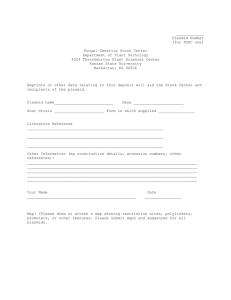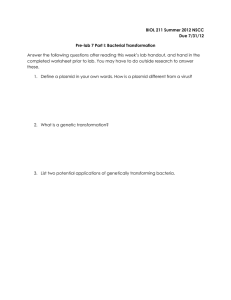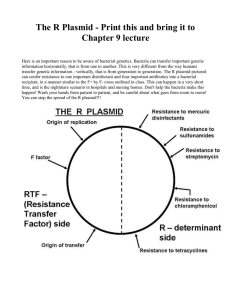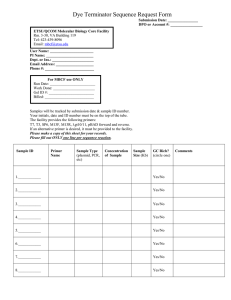UNM TVDC UTSA - UNM Tech Call Minutes: 6/20/06
advertisement
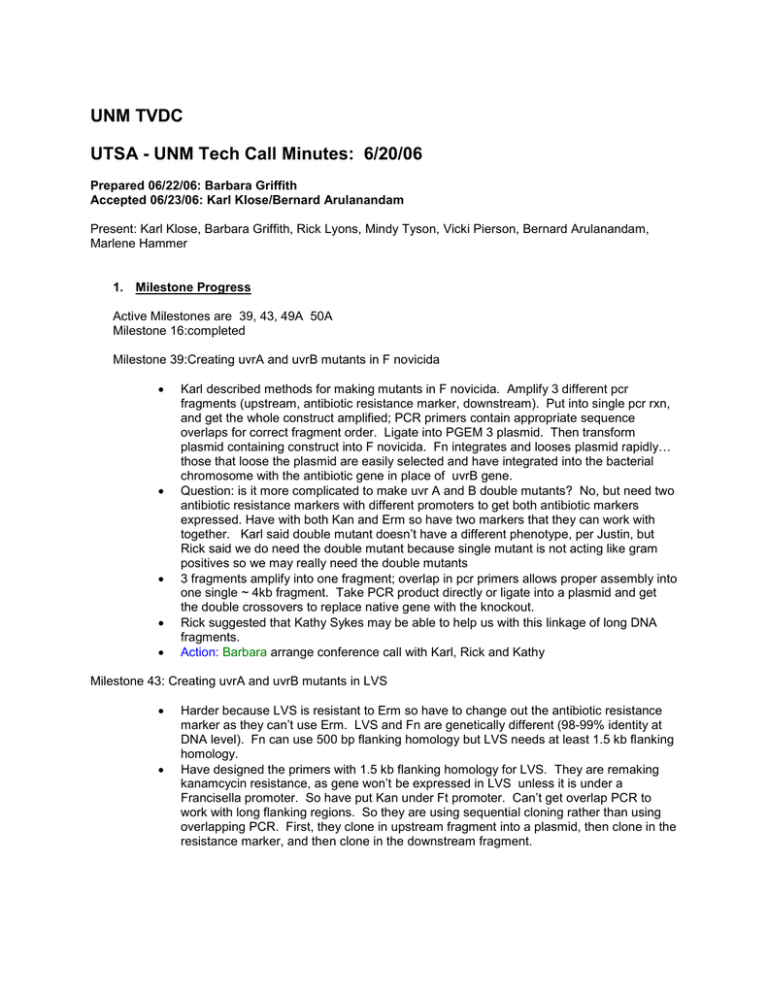
UNM TVDC UTSA - UNM Tech Call Minutes: 6/20/06 Prepared 06/22/06: Barbara Griffith Accepted 06/23/06: Karl Klose/Bernard Arulanandam Present: Karl Klose, Barbara Griffith, Rick Lyons, Mindy Tyson, Vicki Pierson, Bernard Arulanandam, Marlene Hammer 1. Milestone Progress Active Milestones are 39, 43, 49A 50A Milestone 16:completed Milestone 39:Creating uvrA and uvrB mutants in F novicida Karl described methods for making mutants in F novicida. Amplify 3 different pcr fragments (upstream, antibiotic resistance marker, downstream). Put into single pcr rxn, and get the whole construct amplified; PCR primers contain appropriate sequence overlaps for correct fragment order. Ligate into PGEM 3 plasmid. Then transform plasmid containing construct into F novicida. Fn integrates and looses plasmid rapidly… those that loose the plasmid are easily selected and have integrated into the bacterial chromosome with the antibiotic gene in place of uvrB gene. Question: is it more complicated to make uvr A and B double mutants? No, but need two antibiotic resistance markers with different promoters to get both antibiotic markers expressed. Have with both Kan and Erm so have two markers that they can work with together. Karl said double mutant doesn’t have a different phenotype, per Justin, but Rick said we do need the double mutant because single mutant is not acting like gram positives so we may really need the double mutants 3 fragments amplify into one fragment; overlap in pcr primers allows proper assembly into one single ~ 4kb fragment. Take PCR product directly or ligate into a plasmid and get the double crossovers to replace native gene with the knockout. Rick suggested that Kathy Sykes may be able to help us with this linkage of long DNA fragments. Action: Barbara arrange conference call with Karl, Rick and Kathy Milestone 43: Creating uvrA and uvrB mutants in LVS Harder because LVS is resistant to Erm so have to change out the antibiotic resistance marker as they can’t use Erm. LVS and Fn are genetically different (98-99% identity at DNA level). Fn can use 500 bp flanking homology but LVS needs at least 1.5 kb flanking homology. Have designed the primers with 1.5 kb flanking homology for LVS. They are remaking kanamcycin resistance, as gene won’t be expressed in LVS unless it is under a Francisella promoter. So have put Kan under Ft promoter. Can’t get overlap PCR to work with long flanking regions. So they are using sequential cloning rather than using overlapping PCR. First, they clone in upstream fragment into a plasmid, then clone in the resistance marker, and then clone in the downstream fragment. Milestone 49: Construction of iglC mutants in SCHU S4 Constructing iglC mutant in SCHU S4 Need large flanking homology to knock out a gene, just like in LVS SCHU S4 has two copies of pathogenecity island so have to knock out twice. Amplified flanking regions from SCHU S4; overlapping PCR not working due to long length so using sequential cloning . Ligated 3’ region into low copy number vector. Fragments are unstable in E coli in high copy number vectors. Now ligating in Erm cassette into the vector. Got conjugation to work in SCHU S4 as efficiently as possible; get plasmids mated in and recombine into the chromosome in the correct place. Were working with plasmid with a deletion in a beta lactamase gene since Francisella is naturally Amp resistant and this gene is one of the reasons for this. So Karl wanted to knock this gene out anyway. They mated it in and took the bacteria with the beta lactamase gene mated in, and looked at how quickly they loose the plasmid and how often would get the deletion in the chromosome. Those with integrated into chromosome, how quickly lost plasmid and how long into chromosome. Plasmid has puc origin and is unstable in chromosome so plasmid is lost (good!), but none have a deletion which is unfortunate! Very few or none colonies had gene deletion. This construct has limited/shorter flanking homology so need a construct with a long flanking homology in LVS. Can’t get faithful double recombination to occur in holarctica or tularensis without at least 1 to 1.5 kb flanking regions. So whole construct needs to be 1.5kb at each end or longer to get stable recombination. We tried less than 1.5 kb and it just didn’t work, but it was worth trying as a test. Karl would like an amp sensitive strain to use as plasmid marker in the future. Currently limited with Kan and Erm. Has CDC permission for Amp in Francisella, if they can get it to work as marker. An Amp marker would help speed up the process. Some genes are harder to knock out than others! Don’t know why some are harder but others are easier to knock out. In conversation with Fran Nano, Fran has a novel way of knocking out genes in novicida that doesn’t involve a plasmid or a PCR product straight, but it involves taking a PCR product with marker in it and make into a circle rather than linear fragment. It recombines into the chromosome and get plasmid back out again. Usually Karl gets a few colonies but Fran says take out puc origin and they get thousands of colonies with insertions. So if it works in novicida they will try this in SCHU S4 as well. Question: when remove puc origin, how do you get it to replicate? The fragment is no longer replicating. It is a closed circle, not a fragment and doesn’t replicate anymore. When you transform DNA into a bacteria, the exonucleases attack the DNA. Exonucleases start from ends… so a closed circle is much more stable than a linear fragment because exonuclease use circular DNA as a target. They have to circularize it in vitro. Question: could you achieve same result if you used a plasmid whose origin was not recognized by Francisella ? Theoretically, puc is that plasmid because it doesn’t replicate in Francisella. So why remove puc then? Because taking out puc origin, makes incorporation more stable per Nano… puc origin may be important for more than replication; puc origin in Francisella and you get very few colonies and they loose plasmid quickly . Need to keep co-integrated plasmid into the chromosome long enough to select and puc makes the plasmid vector come out quickly. So removing puc is being empirically tested in Karl’s lab. Milestone 50: Immunologic characterization of F.novicida and LVS infected animals Bernard: Got LVS from UNM and grew up and frozen down. 2000 CFU is LD50 in black 6 mice. 2000CFU is similar to Balb/C and NIH Swiss Black 6 mice intranasally with LVS. Got nice dose dependent induction. Did cytokine recall assay with uv irradiate LVS and measured Interferon and IL 4 levels. Bled at day 14 and antibody titers were low so they boosted them , and waiting two weeks. Will isotype antibodies as well. Types of cells coming into respiratory are being characterized after intranasal inoculation . Comparing by flow cytometry to track incoming cells after LVS infection and compare to Fnovicida infection, and picked does of 10 LD 50. Did time course of 24,48 and 72 hrs. want to see the types of cells that go to the lungs after LVS infection and compare to novicida with unique LPS. Protocol is optimized. Will send us data next time. Have staining protocols working. Have two flow cytometers: LSR2 flow and facs caliber with 96 well format too, high throughput. Plans: have uvrB mutant in novicida from Karl and will do LD50 in black 6 mice of uvrB mutant. Based on this data, the mice are highly susceptible to infection. Look at target tissues and plate and look for bacterial dissemination. Will look at lung, liver, and spleen after uvrB infection. Will do intramacrophage survival with uvrB to confirm that is replicating normally and will finish the LVS and novicida flow cytometry on the 24 & 48 hrs after challenge. Action: Bernard needs to send us his UV inactivation of LVS protocol (compare to heat killed or formalin fixed). Send dose and light type etc. UNM wants to look at the best recall antigen and wish to include UV 3. Goals for the next month. MS39: construct plasmid with UvrAupSeqFnP-ErmC-UvrADnSeq; transform into Ft novicida to construct uvrA:ermC mutant MS43: uvrB upstream and downstream fragments will be cloned to make uvrB (LVS) either by stepwise cloning or by overlapping PCR MS49: Construct iglC by cloning 5’ end into pKEK900; iglC moved into mating plasmid, also pUC118FtpKan; continue optimizing gene inactivation in SCHU S4. MS50: Determine LD50 of Ft novicida uvrB; monitor Fn uvrB replication and dissemination in lungs and livers of mice over 3 days post infection; measure intramacrophage survival of uvrB mutants; Use flow cytometry to compare cellular infiltration in lungs after intranasal LVS and Fnovicida infection 4. Other Topics Woods Hole Tularemia Conference: In Karl’s communication with Karen Elkins, finalizing the talk titles and program maybe delaying the meeting registration site. Bernard and other scientific staff are always welcome to join the monthly UTSA technical calls LVS vaccinations:. UTSA needs a nurse to train on reading LVS vaccination sites at USAMRIID Video conferencing- their IT group is working on it And maybe ready at next conference call. 5. Next UTSA Tech Call Tuesday, July 18th. 12pm-1pm MT, 1pm-2pm CT and 2-3pm EST. Karl will be on leave; perhaps Bernard and other senior scientists can represent UTSA on the call
